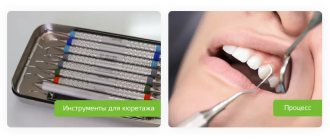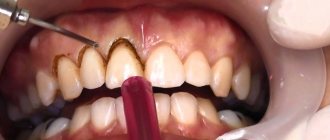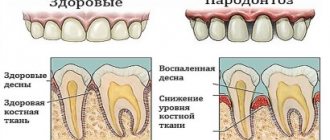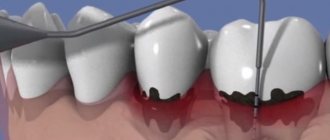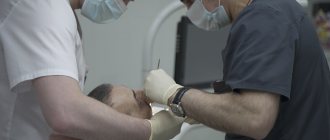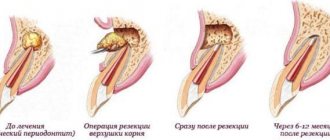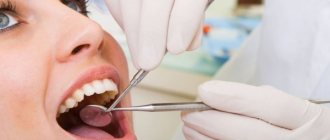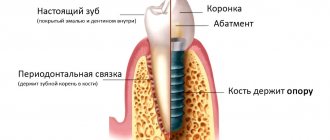From this article you will learn:
- Why is it necessary to perform a gingivectomy?
- Indications for gingivectomy
- Contraindications to gingivectomy
- Methods of performing gingivectomy
- Rehabilitation after gingivectomy
Plaque and food debris often accumulate in the necks of teeth and in the spaces between teeth. These irritants cause inflammation of the gums - gingivitis and periodontitis. Gingivectomy is used to treat periodontal inflammation with irreversible changes, when the pathological process cannot be eliminated by professional hygiene and gentle curettage of periodontal pockets alone.
If the edge of the gum has changed, gingivectomy will help eliminate the affected tissue and stimulate the regeneration of the mucous membrane so that it tightly covers the teeth again, does not bleed, and returns to normal as much as possible.
Gingivectomy is an operation performed by a highly qualified dental surgeon or periodontist. It consists of excision, removal of the edge of the gum. At the same time, a sufficient amount of tissue remains for regeneration. The mucous membrane heals quickly, tightly surrounding the teeth. In this way, deep periodontal pockets and gum growths (as with hypertrophic gingivitis) can be removed.
How to get rid of a gum pocket
To get rid of the gum pocket, a surgical operation is performed - gingivectomy. It is possible with moderate severity of periodontitis, when cleaning the periodontal pocket from tartar, plaque and food debris, as well as medications no longer help. This can be explained by the fact that the gums, after removing stone and food debris, cannot immediately fit tightly to the body of the tooth. A person continues to consume food, and it again ends up in the gum pocket, rots and causes re-inflammation. To prevent this from happening, the edge of the gum must be trimmed a little, removing the gum pocket.
Get a gingivectomy at Dr. Granov's clinic!
Our dentists will carry out the necessary manipulations to get rid of the gum pocket, preventing more serious diseases!
Leave your phone number. The clinic administrator will call you back.
By leaving a request on the site, you consent to the processing of personal data
Make an appointment
Initial consultation with a dentist
400 rubles
Cost of treatment
The final price of the operation is influenced by many factors: procedure technique, area of the operated area, type of anesthesia. If anesthesia or sedation is used, the cost will increase.
When using laser equipment, the price will be higher than when using a scalpel. However, the risk of complications is significantly reduced, and gum health will be restored faster.
Dental surgeons at our clinic use modern equipment. We use safe drugs for sedation or anesthesia. Prices are discussed with the patient before treatment begins.
When is gingivectomy prescribed?
Gingivectomy is recommended when all other therapeutic methods show ineffectiveness:
- taking antibiotics;
- curettage, i.e. cleaning gum pockets;
- scraping of tooth roots
Also, an indication for gingivectomy is the depth of the gum pockets exceeding 4 mm. Deep periodontal pockets can accumulate pathogens that cause:
- gingivitis (when the gum tissue becomes inflamed);
- periodontitis (when the periodontal tissue becomes inflamed);
- periodontitis (when the bone tissue of the tooth begins to become inflamed).
In some cases, gingivectomy is used in aesthetic surgery. After it, the teeth visually become longer and the gums become smoother. However, this procedure has opponents among practicing dentists who claim that there are unjustified risks of gingivectomy on healthy teeth for aesthetic purposes - exposure of the tooth root, inflammation after surgery, etc.
Existing indications for surgery
This surgical intervention becomes possible only if there are certain indications for gingivectomy, expressed in the following pathological changes:
- Hyperplasia of the gum margin (fibromatosis, periodontitis, hypertrophic gingivitis);
- Elongated natural tooth crown;
- Deformation and overhanging gums;
- Proliferation of the interdental papilla;
- Formation of periodontal pockets of pathological depth;
- For cosmetic and aesthetic purposes.
Despite the fact that this is a minor surgical intervention, it is not performed without special reasons. The purpose of the operation is justified if the problem cannot be solved with the help of drug treatment, or the depth of the periodontal pocket does not allow the use of the closed curettage technique.
Contraindications for gingivectomy
Gingivectomy, like any other surgical procedure, has a number of contraindications:
- dysfunction of the immune system;
- blood diseases - bleeding disorders, anemia, leukemia, etc.
- connective tissue diseases;
- cardiovascular diseases - heart rhythm disturbances, recent heart attack, hypertension, etc.;
- acute infectious diseases.
In addition, gingivectomy cannot be done if the inflammatory process has already spread to the bone tissue.
Follow these guidelines after surgery
- Temporarily eliminate the consumption of solid foods, including fresh vegetables.
- Consume foods when they are warmed to room temperature.
- It is not recommended to drink hot or cold drinks.
- Until tissue restoration is complete, alcoholic drinks should be completely excluded from the diet.
- It is also not recommended to smoke until the rehabilitation period is complete.
- Minimize chewing loads on the healing area.
The recovery period for each individual case is different, primarily depending on the food used in the diet. Therefore, during the rehabilitation stage, doctors recommend consuming exclusively soft foods that cannot harm the gums. You also need to brush your teeth very carefully so as not to damage the sutures.
How is gingivectomy performed?
The entire procedure can be divided into three stages. The preparatory stage includes:
- professional teeth cleaning. It is carried out to remove tartar, plaque, food debris, that is, a breeding ground for the development of pathogenic bacteria. In our clinic we offer ultrasonic teeth cleaning;
- administration of an anesthetic drug. The operation is performed under local anesthesia, which lasts for several hours, but this is quite enough to perform all the necessary manipulations. On average, the procedure lasts from half an hour to an hour and a half, depending on the complexity of the case and the amount of work.
Operational stage:
- the surgeon removes periodontal tissue partially or completely depending on the indications. A periodontal pocket can be removed either on one tooth or on several at once. Removal of gum pockets is performed with a scalpel or laser. Our clinic uses a laser - this allows us to minimize postoperative complications;
- After removing the gum tissue, the wound is treated with an antiseptic solution and covered with a special putty, and at the end a sterile bandage is applied. Thanks to all these manipulations, tissue regeneration occurs faster.
At the postoperative stage, the dental surgeon will explain to you how to care for your teeth during the rehabilitation period. In the postoperative period, close attention should be paid to oral hygiene. Brushing your teeth should be gentle - use a brush with soft bristles. Sometimes the doctor recommends not using a brush and thread at all for some time, but using only a special rinse solution.
Procedure
The process of gingivectomy is an operation that must be performed by an oral surgeon as well as a periodontist. The doctor administers local anesthesia and then proceeds directly to the operation. Gingivectomy is performed both with conventional instruments and with a laser.
Simple:
This method involves making wavy incisions of the gums and periosteum in a horizontal plane. The area of influence is the vestibule of the oral cavity and the oral cavity itself. The distance from the periodontal pocket is one millimeter.
Next, vertical incisions are made and the cut off part of the gum is removed. The next stage of the operation is curettage of the wound surface and bone pockets. This is followed by treatment with an antiseptic and the application of a special bandage for at least two days.
Partial / gentle:
This type of gingivectomy received widespread practical use in the mid-twentieth century, or more precisely, in 1962. The method is similar to simple gingivectomy. The main difference is that the excision of non-viable gum is not carried out along the entire wall of the periodontal pocket, but only along part of it (from two to three millimeters). Further manipulations are performed using curettage.
This method is less traumatic and provides an aesthetically more acceptable result, which allows you to include the front part of the gum in the area of treatment.
Radical gingivectomy:
This method has been known to dentists since the beginning of the twentieth century. This is an extremely serious surgical procedure. Six to seven teeth, as well as bone tissue, are simultaneously impacted.
As in the case of a simple gingivectomy, with a radical gingivectomy, wavy incisions are made, but the indentation increases to two millimeters. Along with the gingival margin, overgrown granular tissue, strands of epithelium, remaining dental plaque, and altered bone are removed. The edges of the alveolar arches are aligned at an angle to the outside.
Next, antiseptic treatment is performed. Hemostasis is performed in the wound area and an iodoform turunda or gum bandage is applied. Sometimes the turunda is fixed using an elastic periodontal tray.
Recently, this method has been used quite rarely - only if there are serious indications for radical gingivectomy, since flap periodontal surgery is often preferred.
Attention! Stitching the edges of the wound is highly discouraged. Also, radical gingivectomy is not recommended for the anterior part of the dentition due to aesthetic nuances.
Tools:
Straight scalpel; curved “eye” scalpel; scissors; tweezers for determining the depth of the periodontal pocket; laser.
Duration of the procedure: on average about 30 minutes.
Benefits of laser gingivectomy
Laser gingivectomy has a number of advantages compared to a similar operation performed traditionally:
- the possibility of more precise removal of the edges of the gums, thereby preventing inflammatory processes in very deep layers - dental canals, bone tissue;
- independent oral hygiene becomes more effective because there is access to areas of the tooth that were previously covered with gum pockets;
- Laser surgery is characterized by rapid tissue healing, low trauma and minimal likelihood of complications.
Postoperative period
If the surgical intervention is successful, the recovery period will not be long. It is enough to follow the recommendations of your treating dentist and ensure proper oral care and no complications will arise. Be sure to follow these instructions:
- While the wound is healing, give up alcohol and smoking;
- The food should not be too cold or too hot, ideally warm;
- You should avoid products that can cause injury to your gums;
- Limit chewing loads;
- Maintain careful oral hygiene to avoid the occurrence of suppuration or infection. A soft toothbrush will gently and carefully clean your teeth and will not irritate your gums.
Gingivectomy will solve problems even with a very advanced form of periodontitis, restore healthy appearance to teeth and gums, cleanse gum pockets of pus and bacteria, and make your smile confident and attractive. Remember: healthy and beautiful teeth definitely “live” only in equally healthy gums.
What complications can occur after gingivectomy?
According to the observations of our dentists, complications develop quite rarely after gingivectomy. However, negative consequences can occur if the dentist is not aware of the patient's chronic immune system conditions. Periodontal disease and periodontitis are diseases that occur most often in patients with weakened immune systems. Gingivectomy can also cause complications in chronic connective tissue and cardiovascular diseases. This is explained by the fact that pathogenic bacteria can get into postoperative wounds. If the dentist has as much information as possible about the health status of his patient, he will be able to minimize the risk of such complications.
Gingivectomy - price in dentistry
A mandatory preliminary consultation with a specialist will determine how necessary gingivectomy is in general and which method is optimal in this particular case. Without serious indications, gingivectomy will not be performed.
The price for gingivectomy ranges from 300 rubles to 2,000 rubles for treating the area around one tooth.
Also, many clinics provide services to eliminate the consequences of poorly performed gingivectomy. Some institutions provide video and photographic materials of the gingivectomy operation to introduce the patient to the procedure.
Gingivotomy or gingivectomy
During gingivotomy, the tissue incision is performed vertically in the area of projection of the tooth root in the direction from the free edge of the gum (with or without indentation) to the fold of transition to the moving tissues.
The technique is relevant for the treatment of pathologically shaped periodontal pockets (deep and narrow), as well as for local periodontal and bone abscesses. Gingivectomy is performed primarily through a horizontal incision; it is intended for the surgical treatment of moderate periodontitis (pocket depth from 4 mm) affecting a large gum area. This operation allows you to remove non-viable excess mucous membranes with tissue suturing. Contraindicated for bone abscesses.

